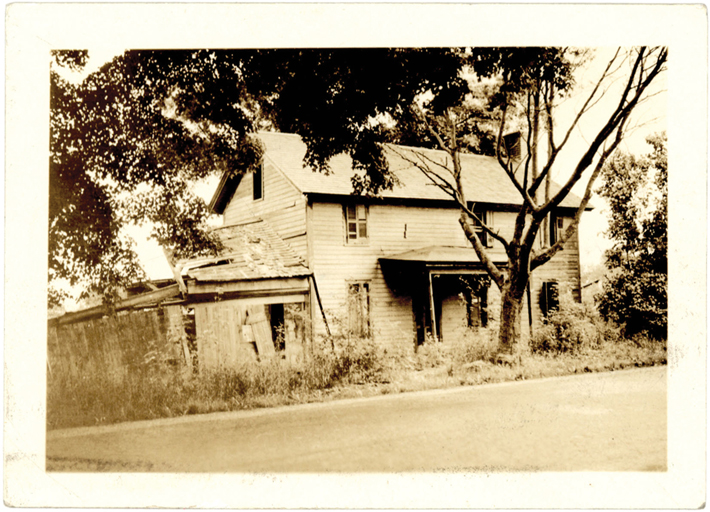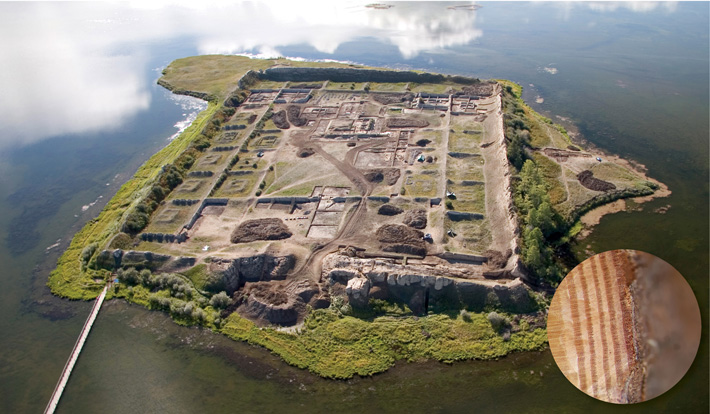Digs & Discoveries
Off the Grid
By MARLEY BROWN
Monday, August 10, 2020
 Off of Route 41 in Great Barrington, Massachusetts, a trail leads visitors around the childhood home of W.E.B. Du Bois, the African American author, scholar, activist, and cofounder of the National Association for the Advancement of Colored People. Born in Great Barrington on February 23, 1868, Du Bois witnessed and chronicled the journey of African Americans through Reconstruction, Jim Crow, and the early Civil Rights movement. As editor of The Crisis magazine, he penned essays on politics, race and class disparities, pan-African identity, and the injustices of colonialism. Du Bois died on August 27, 1963, on the eve of the March on Washington.
Off of Route 41 in Great Barrington, Massachusetts, a trail leads visitors around the childhood home of W.E.B. Du Bois, the African American author, scholar, activist, and cofounder of the National Association for the Advancement of Colored People. Born in Great Barrington on February 23, 1868, Du Bois witnessed and chronicled the journey of African Americans through Reconstruction, Jim Crow, and the early Civil Rights movement. As editor of The Crisis magazine, he penned essays on politics, race and class disparities, pan-African identity, and the injustices of colonialism. Du Bois died on August 27, 1963, on the eve of the March on Washington.
Before he became a public intellectual and world traveler, Du Bois grew up on a small rural homestead belonging to his mother’s family, the Burghardts, who had been brought to the region as enslaved people sometime prior to 1743 and occupied the property starting around 1820. Since the early 1980s, archaeologists have uncovered the foundations of the house, which was demolished after Du Bois sold the property in 1954, as well as thousands of artifacts. According to archaeologist Whitney Battle-Baptiste, director of the W.E.B. Du Bois Center at the University of Massachusetts Amherst, many of the objects reflect the fact that from the mid-nineteenth to the twentieth century, mass-market products became more available to Black consumers. “Because a lot of the materials come from the turn of the century, we see a shift from homemade to mass-produced goods, which became accessible to African Americans via catalogs,” Battle-Baptiste says. “People no longer had to go to local stores, where they might be overcharged or be refused service. Consumption as a practice wasn’t always there for everybody.”
 THE SITE
THE SITE
A parking lot on Route 41 just a five-minute drive from downtown Great Barrington is the start of a trail around the site. Interpretive displays provide background on the history of the Burghardt family and the experience of African Americans in the region. The foundations of the original house are marked with a platform. Up-to-date information about tours, events, and exhibitions at the W.E.B. Du Bois Center in Amherst can be found on the center’s website.
WHILE YOU’RE THERE
Have lunch at one of Great Barrington’s many cafes and restaurants and check out the town’s historic Mahaiwe Performing Arts Center before walking along the scenic Housatonic River, where you will find a park and garden dedicated to Du Bois.
Siberian Island Enigma
By JARRETT A. LOBELL
Monday, August 10, 2020
 It’s hard to imagine that a tiny tree ring could help solve one of the medieval world’s most puzzling mysteries. But by applying the familiar technique of radiocarbon dating in a novel way, scholars have been able to answer the confounding question of why no one ever lived in, or even used, a striking complex of buildings at a site in the Tuva Republic called Por-Bajin.
It’s hard to imagine that a tiny tree ring could help solve one of the medieval world’s most puzzling mysteries. But by applying the familiar technique of radiocarbon dating in a novel way, scholars have been able to answer the confounding question of why no one ever lived in, or even used, a striking complex of buildings at a site in the Tuva Republic called Por-Bajin.
Por-Bajin, or “Clay House” in Tuvan, is located on an island more than 4,000 feet above sea level in southern Siberia’s Lake Tere-Khol. Archaeological explorations of the site started in the late nineteenth century and an extensive research project has taken place there since 2007. It was known from the recent excavations that the 700-by-530-foot complex was constructed by a Uighur khan in a short time, probably a span of two years, in the eighth century A.D. But there has never been a consensus as to which ruler commissioned the complex—or even what its function was. It seemed an ideal place to test something new.
In 2012, Japanese scientist Fusa Miyake identified two spikes in the carbon-14 levels present in tree rings of known age from dendrochronological archives—one in 775, and the other in 994. These surges, now called Miyake Events, were likely produced by massive bursts of cosmic radiation and can be seen in tree rings throughout the world. Por-Bajin was originally thought to have been built in 750 by Bayan-Chur Khan (r. 747–759), ruler of the Uighur Khaganate, and his Chinese princess wife. But this date, as well as the identification of the site as a palace, was based on an inscription found elsewhere. Earlier efforts at radiocarbon dating the larch beams that supported the clay structures were frustratingly inexact. “The problem with routine radiocarbon is precision,” says archaeologist Margot Kuitems of the University of Groningen. “You always end up with a range, usually a few decades. For some periods or monuments this may not matter as much, but for Por-Bajin, with all the questions surrounding it, you really do want to know when, exactly, it was built.”
 Kuitems was able to identify a Miyake Event in the forty-third ring of one of the wooden beams, but the real excitement came when she saw that it was only two rings away from the final ring, meaning that she could confidently conclude that the tree had been felled in 777. She was even able to determine that the tree had been cut down during a warm season, likely the spring, because the ring consisted only of so-called early wood, which is not formed during cold Siberian winters.
Kuitems was able to identify a Miyake Event in the forty-third ring of one of the wooden beams, but the real excitement came when she saw that it was only two rings away from the final ring, meaning that she could confidently conclude that the tree had been felled in 777. She was even able to determine that the tree had been cut down during a warm season, likely the spring, because the ring consisted only of so-called early wood, which is not formed during cold Siberian winters.
Sometime before 777, the Uighur ruler Tengri Bögü Khan (r. 759–779), Bayan-Chur Khan’s son, changed the Khaganate’s official religion from Tengrism, a shamanistic tradition, to the Gnostic faith of Manichaeism. In 777, the researchers’ findings establish, he began construction of Por-Bajin.
The khan’s conversion was to be his downfall—in 779, he was assassinated during an anti-Manichaean uprising. Based on the precise date of the complex and the fact that it showed no signs of ever having been occupied or used, archaeologists now believe that Por-Bajin was not, in fact, a palace at all, but a Manichaean monastery that was abandoned after Tengri Bögü Khan’s death and the Khaganate’s return to Tengrism. “We began our research hoping to achieve a proof of concept,” says Kuitems. “We didn’t expect to be able to solve a mystery with science.”
Advertisement
Advertisement
IN THIS ISSUE
Digs & Discoveries
Siberian Island Enigma
Off the Grid
Closing in on a Pharaoh's Tomb
A Rare Egg
Mouse in the House
Commander's Orders
The Means of Production
Yesterday, Today, and Tomorrow
Missing Mosaics
Stonehenge's New Neighbor
Dark Earth in the Amazon
Reindeer Training
Around the World
A president’s torpedo boat, Cahokia corn farmers, a Viking surprise, and Genghis Khan in winter
Artifact
Reeling in the years
Advertisement

Recent Issues
-
 May/June 2024
May/June 2024
-
 March/April 2024
March/April 2024
-
 January/February 2024
January/February 2024
-
 November/December 2023
November/December 2023
-
 September/October 2023
September/October 2023
-
 July/August 2023
July/August 2023
-
 May/June 2023
May/June 2023
-
 March/April 2023
March/April 2023
-
 January/February 2023
January/February 2023
-
 November/December 2022
November/December 2022
-
 September/October 2022
September/October 2022
-
 July/August 2022
July/August 2022
-
 May/June 2022
May/June 2022
-
 March/April 2022
March/April 2022
-
 January/February 2022
January/February 2022
-
 November/December 2021
November/December 2021
-
 September/October 2021
September/October 2021
-
 July/August 2021
July/August 2021
-
 May/June 2021
May/June 2021
-
 March/April 2021
March/April 2021
-
 January/February 2021
January/February 2021
-
 November/December 2020
November/December 2020
-
 September/October 2020
September/October 2020
-
 July/August 2020
July/August 2020
-
 May/June 2020
May/June 2020
-
 March/April 2020
March/April 2020
-
 January/February 2020
January/February 2020
-
 November/December 2019
November/December 2019
-
 September/October 2019
September/October 2019
-
 July/August 2019
July/August 2019
-
 May/June 2019
May/June 2019
-
 March/April 2019
March/April 2019
-
 January/February 2019
January/February 2019
-
 November/December 2018
November/December 2018
-
 September/October 2018
September/October 2018
-
 July/August 2018
July/August 2018
-
 May/June 2018
May/June 2018
-
 March/April 2018
March/April 2018
-
 January/February 2018
January/February 2018
-
 November/December 2017
November/December 2017
-
 September/October 2017
September/October 2017
-
 July/August 2017
July/August 2017
-
 May/June 2017
May/June 2017
-
 March/April 2017
March/April 2017
-
 January/February 2017
January/February 2017
-
 November/December 2016
November/December 2016
-
 September/October 2016
September/October 2016
-
 July/August 2016
July/August 2016
-
 May/June 2016
May/June 2016
-
 March/April 2016
March/April 2016
-
 January/February 2016
January/February 2016
-
 November/December 2015
November/December 2015
-
 September/October 2015
September/October 2015
-
 July/August 2015
July/August 2015
-
 May/June 2015
May/June 2015
-
 March/April 2015
March/April 2015
-
 January/February 2015
January/February 2015
-
 November/December 2014
November/December 2014
-
 September/October 2014
September/October 2014
-
 July/August 2014
July/August 2014
-
 May/June 2014
May/June 2014
-
 March/April 2014
March/April 2014
-
 January/February 2014
January/February 2014
-
 November/December 2013
November/December 2013
-
 September/October 2013
September/October 2013
-
 July/August 2013
July/August 2013
-
 May/June 2013
May/June 2013
-
 March/April 2013
March/April 2013
-
 January/February 2013
January/February 2013
-
 November/December 2012
November/December 2012
-
 September/October 2012
September/October 2012
-
 July/August 2012
July/August 2012
-
 May/June 2012
May/June 2012
-
 March/April 2012
March/April 2012
-
 January/February 2012
January/February 2012
-
 November/December 2011
November/December 2011
-
 September/October 2011
September/October 2011
-
 July/August 2011
July/August 2011
-
 May/June 2011
May/June 2011
-
 March/April 2011
March/April 2011
-
 January/February 2011
January/February 2011
Advertisement






